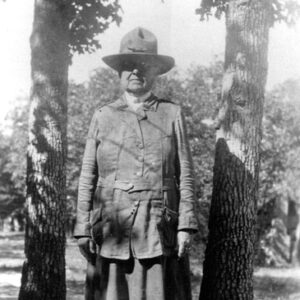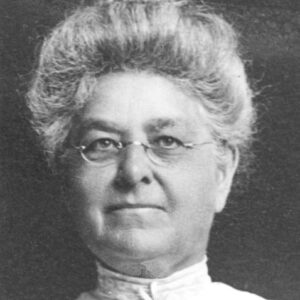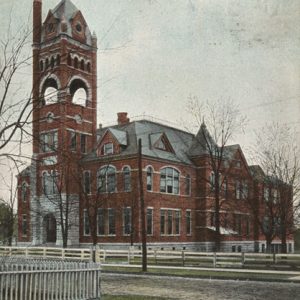calsfoundation@cals.org
Ida Josephine Brooks (1853–1939)
Ida Josephine Brooks was a teacher and early school administrator in Little Rock (Pulaski County). She was among Arkansas’s earliest women physicians and the first female faculty member at the University of Arkansas Medical School (now the University of Arkansas for Medical Sciences). She also took an active role in advocating for women’s rights.
Ida Joe Brooks, the fourth of six children, was born at Muscatine, Iowa, on April 28, 1853, to Methodist minister Joseph Brooks and Elizabeth Goodenough Brooks. Brooks’s father was a candidate for governor in Arkansas in 1872 against Elisha Baxter. Both candidates claimed victory, precipitating the Brooks-Baxter War, with Brooks the loser. Little is known of Ida Joe Brooks’s childhood education. She graduated from Central High School in St. Louis, Missouri, in 1870 and moved to Little Rock with her family. Her AB degree was awarded from Little Rock University, a private college, in 1877.
After teaching for several years in the Little Rock public schools, she continued her studies at Drury College in Springfield, Missouri, where she received her master’s degree.
Brooks began her Arkansas career in education in 1873 as a teacher at the Primary Department of the First Ward School located at 7th and Sherman streets in Little Rock. A year later, at the age of twenty-one, she became principal of the Intermediate Department at the same school. After receiving her master’s degree from Drury College, Brooks returned to Little Rock University as a faculty member, where she taught mathematics from 1882 to 1888.
After fifteen years as an Arkansas educator, Brooks began the study of medicine at the Boston University School of Medicine, one of the earliest medical schools to accept women. She had been refused admission to the University of Arkansas Medical Department in 1887 because of her gender. Her thesis was titled “Neurasthenia,” indicating her early interest in psychiatry. Brooks graduated with an MD in 1891. The training of physicians at this time included three primary types of physicians—regular physicians (allopaths), root and herb (botanical) physicians trained in the Samuel Thompson school, and homeopaths trained according to the principles of Samuel Hahnemann. All were considered MDs. Hahnemann’s theory of medicine was based on the theory that diseases are curable by those drugs that produce effects on the body similar to the symptoms. The treatments consisted of minute doses of medicine rather than heroic therapies.
From 1903 until her return to Little Rock in 1906, Brooks specialized in psychiatry at the Massachusetts Mental Hospital in Middleborough. She established a private practice of pediatrics in 1903 after taking special studies in mental disorders, including the practice of psychiatry. In 1914, Brooks became the first female faculty member at the University of Arkansas Medical School. She was a lecturer on social hygiene in the psychiatry department—“practical matters of health maintenance such as diet, cleanliness, and emotional first aid.” She was later named associate professor of psychiatry.
Brooks was prominent in the arena of women’s rights in Arkansas during her long career. Sometime after her return to Little Rock in 1882, she addressed the Columbian Club of Little Rock—an extension of Arkansas’s Columbian Commission, which was formed to plan the furnishings for the Arkansas building at the 1893 Columbian Exposition in Chicago—in the Senate chamber on the topic “Women in Medicine.” Her thesis was that Arkansas should admit women as students in the medical school.
Also unusual for the time, Brooks attempted to enlist in the military service during World War I, but she was denied because of her gender. She then obtained a commission in the U.S. Public Health Service and served at Camp Pike as a consultant in psychiatry at the rank of assistant surgeon. After the war, she returned to work for the Little Rock School District as health director and psychiatrist for city schools.
Because of her interest in treating the mentally ill and her love for children, Brooks advocated the establishment of a school for “mentally deficient” students. The Little Rock School Board of Directors established the school in the basement of Kramer School in October 1913; at that time, it was the only one in the state and the first school of its kind in Arkansas. It was discontinued in 1917.
Because of Brooks’s combined zeal for education and her love of medicine, the Republican Convention of Arkansas nominated her for the office of State Superintendent of Public Instruction in 1920. However, once again, her gender interfered. The attorney general ruled that women were not eligible to hold public office, so her name was not on the ballot.
Brooks was a leader in both education and medicine. She was president of both the Homeopathic Medical Examining Board and the Arkansas State Teachers Association in 1877. She was active in many civic organizations, including the Altrusa Club and the Woman’s City Club of Little Rock.
Brooks died on March 13, 1939, at St. Vincent Infirmary in Little Rock from the shock and strain of a fractured hip, complicated by a weakened heart. She is buried in St. Louis at Bellefontaine Cemetery.
For additional information:
Brooks, Dr. Ida Joe. “Women in Medicine.” Pulaski County Historical Review 44 (Winter 1996): 90–93.
“Brooks, Ida Josephine.” In American Medical Directory. 15th ed. Chicago: American Medical Association, 1938.
Ida Josephine Brooks MD Biography File. University of Arkansas for Medical Sciences Library, Little Rock, Arkansas.
Williams, Nancy A., ed. Arkansas Biography: A Collection of Notable Lives. Fayetteville: University of Arkansas Press, 2000.
Fred O. Henker and Edwina Walls Mann
Little Rock, Arkansas
 Early Twentieth Century, 1901 through 1940
Early Twentieth Century, 1901 through 1940 Education, Higher
Education, Higher Health and Medicine
Health and Medicine Ida Joe Brooks
Ida Joe Brooks  Ida Joe Brooks
Ida Joe Brooks  Kramer School
Kramer School 




Comments
No comments on this entry yet.